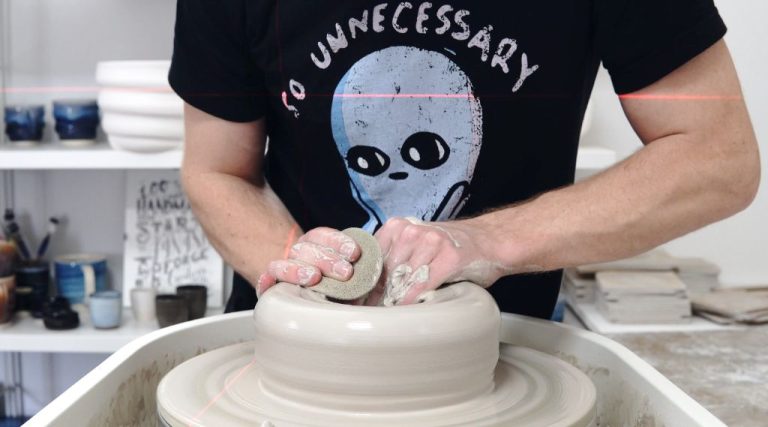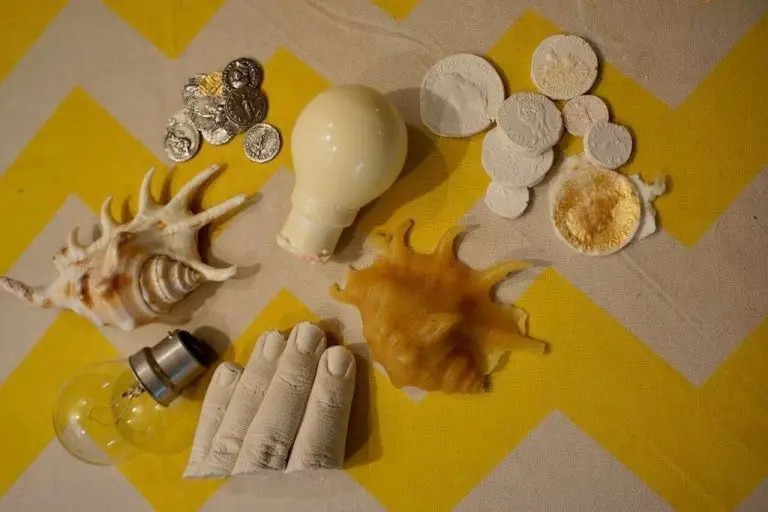Is A Coffee Mug Considered Pottery?
Definition of Pottery
Pottery is defined as objects made of clay and hardened by heat. According to the Merriam-Webster dictionary, pottery refers to “ware (such as vases, pots, bowls, or plates) shaped from clay and hardened by heat” (Merriam-Webster). Pottery is made by shaping wet clay into desired forms and then firing the clay in a kiln to harden the material through sintering. The clay’s chemical water combined with carbon dioxide is driven off in the firing process, causing the remaining clay material to be hardened and durable. Thus, pottery encompasses any clay objects that have gone through this process of shaping, drying, and firing or heating.
History of Pottery
Pottery first emerged during the Neolithic period around 9,000 BCE in East Asia and other regions including the Middle East, India, and Africa. Early pottery found in China, dating back 20,000 years, consisted of crude clay figurines. However, evidence shows that functional pottery began much later, around 18,000 BCE in East Asia. [1]
The earliest known pottery, found in Xianrendong Cave in China, was made from clay, quartz sand, and crushed feldspar. This pottery dates back 20,000 years ago and provides evidence that early pottery-making was already established in East Asia during the Late Glacial Maximum. [1]
As early potters began to master basic techniques, pottery developed concurrently in many regions around 6,500-4,000 BCE, aided by the spread of agriculture and new firing technology. Pottery from this era was utilitarian in purpose, used mainly for storing food. Common early materials included clay mixed with silica-rich sand, crushed shells, or crushed bones to temper the clay. Potters shaped these materials into basic but functional vessels by hand or using small molds.
Around 6,000 BCE, the potter’s wheel was invented in Mesopotamia, which revolutionized the production process. The wheel enabled potters to create symmetrical vessels and new shapes much faster. Glazing techniques were also developed around this time using slip, made of clay and water, to coat the surface before firing. These innovations led to more advanced forms of pottery. [2]
Types of Pottery
There are three main types of pottery: earthenware, stoneware, and porcelain. Each type varies in terms of ingredients, firing method, hardness, porosity, and intended use (https://deneenpottery.com/pottery/ ).
Earthenware is made from clay and fired at lower temperatures, typically between 1000-1200°F. It is porous and less durable than other types. Earthenware can be glazed to make it non-porous. It is often used for more utilitarian purposes like flower pots and dishes. Some types of earthenware pottery include terracotta and stoneware (https://en.wikipedia.org/wiki/Pottery).
Stoneware is made from clay, often mixed with materials like sand, quartz, or grog to increase durability. It is fired around 1200-1300°F, making it partially vitrified and less porous than earthenware. Stoneware is commonly used for utilitarian items like crocks and bowls. It can also be glazed to make decorative pieces.
Porcelain is made from the finest clays and minerals like kaolin fired at very high temperatures, usually over 1300°F. The high firing makes porcelain non-porous, hard, and glass-like. Porcelain is commonly used to create delicate tableware and decorative items. It can be left unglazed for a matte look or glazed for a shiny finish.
Coffee Mug Materials
Coffee mugs can be made from a variety of materials including:
Clay – Clay is one of the original materials used to create pottery and ceramics. Many modern coffee mugs are still made from clay due to its affordability, durability, and insulating properties.
Ceramic – Ceramic mugs refer to any mugs made from inorganic nonmetallic materials like clay that are hardened by high heat. Ceramic mugs are a popular choice because they retain heat well and come in many styles and colors.
Glass – Glass mugs allow you to see the color of your coffee while also resisting stains and odors. However, they don’t retain heat as well as ceramic or stainless steel.
Plastic – Plastic mugs like acrylic are inexpensive, lightweight, and durable. However, some lower quality plastics may absorb smells and stains over time.
Metal – Stainless steel mugs have excellent heat retention and are very durable. Other metals like copper may impart subtle flavor. But metal can get very hot.
Porcelain – Porcelain mugs are a high quality type of ceramic mug known for their thin, translucent white appearance. They have low porosity making them easier to clean.
Source: https://pixelfy.me/guides/home/best-coffee-mugs/
Coffee Mug Manufacturing
The manufacturing process for ceramic coffee mugs involves several key steps including shaping and molding, glazing and decorating, and firing. Here is an overview of how coffee mugs are made:
Shaping and Molding: The clay body that makes up the mug is shaped by pouring slip (liquid clay) into a plaster mold. The slip coats the inside of the mold and is then poured out, leaving a layer of clay that replicates the shape of the mold. Another method is to press soft clay into the mold by hand.
Glazing and Decorating: Once shaped, the unfinished mug is dried and then decorated. Designs can be hand-painted, printed using transfers, or engraved into the surface. The mug is then coated with glaze, giving it a glossy finish and sealing the porcelain. Glazes come in various colors and textures.
Firing Process: After glazing, the mugs are loaded into a high temperature kiln that heats to over 1000°C. Firing fuses the glaze to the clay body and hardens the finished mug. Firing times vary based on factors like clay type and thickness. The complete firing process can take 24 hours or longer.
Some modern techniques like ram pressing allow faster mass production of mugs. But the basic steps of molding, decorating, and firing remain essential to creating a ceramic coffee mug.
Source: https://unifury.com/blogs/gifting-guide/how-ceramic-mugs-are-made
Purpose and Uses
Coffee mugs have two main purposes as both everyday drinkware and decorative collectibles. As drinkware, coffee mugs are one of the most common vessels used for enjoying hot and cold beverages. Their sturdy build and insulating properties make them ideal for holding hot coffee, tea, cocoa, and other drinks without burning the hands. The handle allows for secure and comfortable gripping while sipping. Coffee mugs are a kitchen staple and the everyday drinkware of choice for many households.
In addition to being useful utilitarian objects, coffee mugs are also popular decorative collectibles and novelty gift items. Their versatile shape allows for an endless variety of designs, colors, and decorations. Coffee mugs often have eye-catching artwork or funny sayings printed on them. Popular themes include sports teams, movies, TV shows, travel destinations, hobbies, and more. Specialty coffee mugs are frequently collected and displayed in homes and offices. Some collectors aim to acquire mugs representing places they’ve traveled or experiences they’ve had. The variety and customization potential have made coffee mugs a beloved keepsake and gift purchase.
While plain mugs serve a simple drinkware purpose, decorated and artistic mugs take on additional roles as decorative objects for display. As both useful tools and fun collectibles, coffee mugs have become a staple of households and workplaces. (Source)
Qualities of Pottery
Pottery is defined by two key qualities of the clay it is made from: plasticity and hardening when fired in a kiln. Plasticity refers to the clay’s ability to be molded into shapes which it then retains after molding. The clay maintains its molded shape through the process of drying and hardening. After shaping, pottery must be fired in a kiln, which hardens the clay fully through vitrification, the process of the clay melting and then cooling to become a hardened, glass-like substance.
According to the Encyclopedia Britannica, the clays used for pottery are fine-grained sediments rich in the hydrated aluminum silicates known as clay minerals. The most common clay minerals include kaolin and various types of smectites and illites. The plasticity of the clay depends on the amounts of each mineral present. Kaolin provides plasticity without shrinkage, while smectites and illites provide bonding strength when dried. The ideal pottery clay contains a balance of these minerals to achieve the desired plasticity and strength when fired.[1]
Through this process of proper clay composition, molding, and kiln firing, pottery develops its key durable and hard physical qualities that distinguish it as a unique material and artform.
[1] “Pottery.” Encyclopedia Britannica, https://www.britannica.com/art/pottery. Accessed [date accessed].
Are Coffee Mugs Considered Pottery?
When determining if coffee mugs can be classified as pottery, it is important to compare their qualities and composition to the established definition of pottery. Some key factors to consider include:
Pottery is defined as ceramic ware made from clay and hardened by heat. Ceramic mugs can be considered a type of pottery since they are made from clay and fired at high temperatures in a kiln. However, not all coffee mugs today are made purely from clay.
Many modern coffee mugs are made from porcelain, which is a specific type of ceramic that contains kaolin clay along with other ingredients like feldspar and quartz. Porcelain is considered a premium type of pottery due to its white color, durability, and delicate translucency (Source).
Some coffee mugs are made from stoneware, which is a dense pottery that contains clay but is fired at higher temperatures than typical ceramic. Since stoneware meets the criteria of being clay-based and kiln-fired, it can also fall under the pottery category (Source).
On the other hand, not all modern coffee mugs are made from clay-based ceramics or porcelain. Glass, plastic, and stainless steel are also common materials used to make coffee mugs today, and these would not be classified as pottery since they do not contain clay.
In conclusion, while porcelain and ceramic coffee mugs can be considered types of pottery, mugs made from other materials like glass or metal do not meet the definition of pottery. The clay composition and kiln-firing process are key determinants of what constitutes pottery.
Expert Opinions
On a post in the r/Pottery subreddit, a user who has been making pottery for over 40 years provides insight into evaluating the quality of handmade mugs:
“I’d like to know what y’all think of the shape of the body, lip, and, handle. Also the proportions of the curves and handle to cup size. These all make a huge difference between an awkward, clunky mug and one that feels ‘just right’ when you pick it up.” (Source)
YouTube ceramicist Karaleigh Ann explains factors that determine the value of handmade pottery like mugs:
“Educating customers on why pottery costs what it costs can only benefit both parties – those that buy my mugs will treasure their unique pieces of art which took hours or love, skill, time, tools and materials to create.” (Source)
Overall, expert ceramicists emphasize that high quality handmade mugs require extensive time and skill to perfect the shape, proportions, feel, and artistry. This accounts for their higher value compared to mass-produced mugs.
Conclusion
Based on the definition, history, manufacturing, and qualities of pottery, as well as other perspectives, there are a few key points that summarize whether coffee mugs can be considered pottery:
– Clay is the primary material used to make pottery. While some coffee mugs are made of clay, many are made of porcelain, ceramic, glass, or even plastic which have different properties and manufacturing processes than traditional clay pottery.
– Pottery is shaped from clay by hand or with a potter’s wheel, then heated in a kiln to harden. Most mass-produced coffee mugs today are made by machines for speed and uniformity rather than shaped individually.
– Pottery is considered an artisanal craft that results in some variation between pieces. In contrast, coffee mugs made via automation result in consistency between each mug.
– The purposes behind pottery tend to be decorative, artistic, or ceremonial. While coffee mugs can be decorative, their primary purpose is utilitarian and functional.
– So in summary, while some artisan-made clay coffee mugs could technically be classified as pottery, many mass-produced coffee mugs have different materials, methods of production, and purposes that would likely disqualify them from being considered true pottery.



